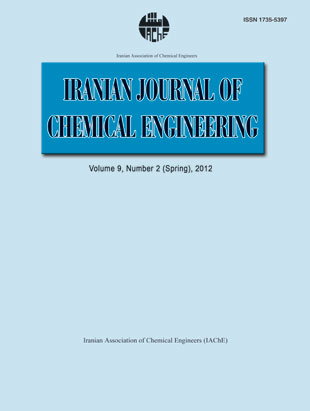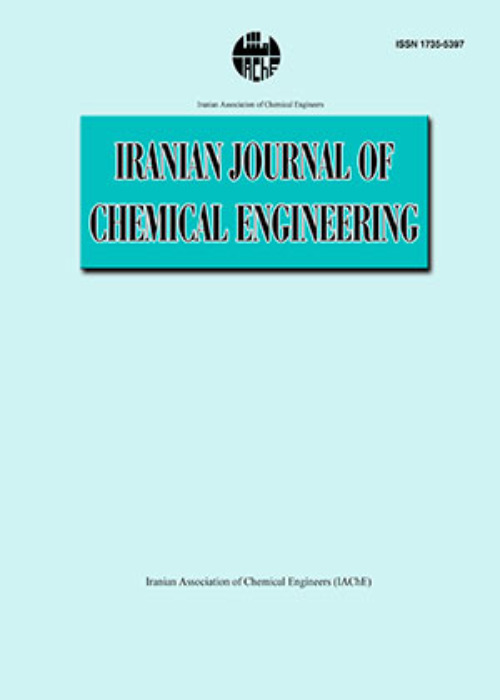فهرست مطالب

Iranian journal of chemical engineering
Volume:9 Issue: 2, Spring 2012
- تاریخ انتشار: 1391/05/19
- تعداد عناوین: 8
-
-
Page 3Addition of impurities has an important role on the kinetic crystallization. Therefore, influence of impurities on the crystallization kinetics of NaCl, KBr, ADP and Sucrose solutions was investigated in a fluidized bed crystallizer. The growth and dissolution rates were related to the super saturation and impurity concentration. A strong mathematical model is applied to describe crystal growth rates within aqueous solutions as a function of impurity concentration. The model tries to relate the step velocity to the useful parameters such as the surface coverage (θeq), as well as the effectiveness factor of impurity, α. When α>1, the step velocity is stopped at θeq <1 (incomplete coverage of the active sites for adsorption). In the case of α=1, the velocity reaches zero just at θeq=1 (complete coverage) but approaches a limiting value. The value of α is changed by stereo chemical factors and decreases as the supersaturation is increased. The Langmuir adsorption isotherm is used to relate the relative step velocity with the impurity concentration in solution. Experimental results show that increasing the amount of impurity concentration leads to a decrease in the step velocity. Experimental data and model predictions have been compared to show that the agreement between them is very good. The obtained results are suitable for designing and quality control of the crystallization processes in chemical industries.Keywords: Crystal Growth Rate, Impurity Effectiveness Factor, Super Saturation, Step Velocity
-
Page 14A commercial flat polymeric membrane (PERVAP 2201) was employed in vapor permeation process to selectively remove water from the reaction atmosphere during the synthesis of isopropyl propionate from iso-propanol and propionic acid. The reaction was carried out in a bench scale batch reactor at three different values of alcohol/acid molar ratio (1:1, 1.5:1 and 3:1) with 3 wt% para toluene sulfonic acid (with respect to acid) as catalyst.. The polymeric membrane was in contact with only the volatile components, namely water and isopropanol, for a long period of time with no detectable defect. The conversion of the reversible esterification reaction was enhanced by simultaneous employing of the chemical reaction and the vapor permeation process, where in a set of experiments almost complete conversion was achieved after only 140 minutes. Also, results revealed that initial molar ratio of the reactants had strong effects on the acid conversion and water permeation flux through the membrane.Keywords: Esterification, Membrane Reactor, Isopropyl Propionate, Polymeric Membrane
-
Page 22Catalysts with the formula of LaCoMnxO(3+δ), where x is 0.0, 0.2, 0.3 and 0.5 were studied for CO and C2H6 oxidation. Ethane was selected as a model for hydrocarbon combustion. Samples were prepared by the citrate method and calcined at 600oC for 8 h. Prepared catalysts were characterized by FT-IR, XRD, SEM, TEM, TPR and EDS analyses. Structural studies show that the manganese oxide addition up to 0.5 mol, i.e. 50%, has no effect on the LaCoO3 perovskite phase formation. Crystallite size of different phases, comprising perovskite and manganese oxide, was determined by the Scherrer equation. Addition of 0.3 mol manganese was observed to improve the catalytic property of the lanthanum cobaltite; oxidizes the CO and hydrocarbons at lower temperature.Keywords: Mixed Oxides, LaCoO3, Manganese Oxide, CO Oxidation, Hydrocarbon Oxidation, Perovskite
-
Page 34In this work, a new thermodynamic model based on the perturbation theory is presented. A new hard spheres equation of state as a reference term is applied to correlate the activity coefficient of amino acids and peptides in binary aqueous solutions. The new hard sphere equation of state has been recently proposed by Dehghani and Modarress [11] and has been applied for different theories and showed excellent capability. In this model dipole-dipole and Lennard-Jones interactions are considered. The results have been compared with similar models and it is shown that application of the new hard spheres equation of state has caused an improvement in the results of perturbation model.Keywords: Activity Coefficient, Hard Sphere, Perturbation Model, Amino Acid
-
Page 43Turbulent flow field in a 200 m3 industrial suspension polymerization reactor, which is a baffled agitated vessel, was simulated using CFD. Multi-reference frame (MRF) methods and k-ε turbulence model were used to solve turbulent flow equations. It was found that turbulent flow field in reactor is non-homogenous. This non-homogeneity is especially common among three compartments of a reactor based on turbulent kinetic energy (TKE) dissipation rate. A compartment around the impeller with very high rate of TKE dissipation (impeller zone), a compartment around the baffles with a relatively high rate of TKE dissipation (baffle zone) and a relatively big compartment in bulk of flow with low TKE dissipation rate (circulation flow). Therefore a three-compartment model was used to explain the non-homogeneity of turbulent flow field. The parameters of this model are compartment volume ratios (μi and μb), compartment energy dissipation ratios (λb and λi) and exchange flow rates (Qi and Qb), which were obtained from simulations for different agitation rates.Keywords: CFD, Suspension Polymerization, Turbulent Flow, Three, compartments
-
Page 54Drop size distribution and Sauter-mean drop diameters have been measured in a pilot scale Hanson mixer-settler extraction column for two different liquid-liquid systems. The experiments were carried out for both mass transfer directions. The effects of agitation speed and dispersed phase and continuous phase flow rates have been investigated under a variety of operating conditions. Mean drop diameter axial profiles show a strong nonuniformity, while drop size distribution does not change significantly with the column height. Sauter mean diameter and drop size distribution are strongly affected by agitation speed and interfacial tension. Significant, but weaker are the effects of continuous phase and dispersed phase flow rates. An empirical correlation for mean drop size as a function of Weber number, dispersed phase holdup, and viscosities ratio is suggested. In a further correlation, the dispersed phase holdup is replaced by flow rates which will certainly be known in a practical case.Keywords: Sauter, mean Diameter, Drop Size Distribution, Hanson Mixer, settler, Dispersed Phase Holdup
-
Page 66The partial differential equations describing reaction of a trace component in the gas stream in a packed bed of solid reactant or adsorbent are solved by Rayleigh-Ritz finite element method. These equations consist of a PDE along the reactor which is accompanied with semi time dependent diffusion-reaction equation in each pellet. Two gas-solid reaction models have been considered as the reaction rate expression of the pellets in this work. These reaction rates provide nonlinearity in the PDEs of the pellets. Reactions with considerable structural changes such as sulfation of calcined limestone in packed column have been considered too. The finite element method analyzed the PDEs equations, even in the presence of steep gradients associated with nonlinearities along the packed column and the pellets equations.Keywords: Finite Element Method, Rayleigh, Ritz, Nonlinear Partial Differential Equations, Non, catalytic Packed Bed Reactors
-
Page 84


